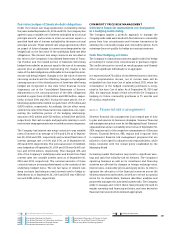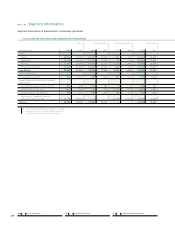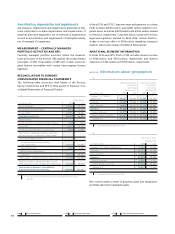Siemens 2014 Annual Report Download - page 305
Download and view the complete annual report
Please find page 305 of the 2014 Siemens annual report below. You can navigate through the pages in the report by either clicking on the pages listed below, or by using the keyword search tool below to find specific information within the annual report.
247 D. Consolidated Financial Statements 337 E. Additional Information
248 D. Consolidated Statements of Income
249 D. Consolidated Statements of Comprehensive Income
250 D. Consolidated Statements of Financial Position
251 D. Consolidated Statements of Cash Flows
252 D. Consolidated Statements of Changes in Equity
254 D. Notes to Consolidated Financial Statements
330 D. Supervisory Board and Managing Board
are the maximum amounts Siemens could be required to settle
in the event of default or non-payment by the primary debtor.
For additional information regarding credit guarantees see
NOTE COMMITMENTS AND CONTINGENCIES. To monitor existing
financial assets and liabilities as well as to enable an effective
controlling of future risks, Siemens has established a compre-
hensive risk reporting covering its worldwide business units.
CREDIT RISK
Credit risk is defined as an unexpected loss in cash and earn-
ings if the customer is unable to pay its obligations in full and
on time or if the value of collateral declines.
Siemens provides its customers with various forms of direct
and indirect financing particularly in connection with large
projects. Siemens finances a large number of smaller customer
orders, for example the leasing of medical equipment, in part
through SFS. SFS is also exposed to credit risk by financing
third-party equipment or by taking direct or indirect participa-
tions in financings, such as syndicated loans. In part, Siemens
takes a security interest in the assets Siemens finances or
Siemens receives additional collateral. Siemens may incur
losses if the credit quality of its customers deteriorates or if
they default on their payment obligations to Siemens, such as
a consequence of a financial or political crisis and a global
downturn.
The effective monitoring and controlling of credit risk is a core
competency of our risk management system. Siemens has im-
plemented a binding credit policy for all entities. Hence, credit
evaluations and ratings are performed for all customers with an
exposure or requiring credit beyond centrally defined limits.
Customer ratings, analyzed and defined by SFS, and individual
customer limits are based on generally accepted rating meth
-
odologies, with the input consisting of information obtained
from the customer, external rating agencies, data service pro-
viders and Siemens’ customer default experiences. Ratings and
credit limits are carefully considered in determining the condi-
tions under which direct or indirect financing will be offered to
customers. As part of the process, internal risk assessment spe-
cialists determine and continuously update ratings and credit
limits for Siemens’ public and private customers. For public
customers our policy provides that the rating applied to individ
-
ual customers cannot be better than the weakest of the sover-
eign ratings provided by Moody’s, S & P’s and Fitch for the
respective country.
Credit risk is recorded, analyzed and monitored on an ongoing
basis applying different systems and processes dependent on
the financial instrument. Central systems are used for ongoing
monitoring of counterparty risk. In addition, SFS uses own
systems for its financing activities. There are also a number of
decentralized tools used for management of individual credit
risks within the operating units. A central IT application pro-
cesses data from the operating units together with rating and
default information and calculates an estimate which may be
used as a basis for individual bad debt provisions. In addition to
this automated process, qualitative information is considered,
in particular to incorporate the latest developments.
To increase transparency with regard to credit risk Corporate
Treasury has established the Siemens Credit Warehouse to
which numerous operating units from the Siemens Group reg-
ularly transfer business partner data as a basis for a centralized
rating process. In addition, numerous operating units transfer
their trade receivables with a remaining term up to one year
along with the inherent credit risk to the Siemens Credit
Warehouse, but remain responsible for servicing activities
such as collections and receivables management. The Siemens
Credit Warehouse actively identifies, quantifies and manages
the credit risk in its portfolio, such as by hedging exposure
to specific customers, countries and industries. In addition to
an increased transparency with regard to credit risk, the
Siemens Credit Warehouse may provide Siemens with an addi-
tional source of liquidity and strengthens Siemens’ funding
flexibility.
The maximum exposure to credit risk of financial assets, with-
out taking account of any collateral, is represented by their car-
rying amount. As of September , and the collateral
for financial instruments classified as financial assets measured
at fair value in the form of netting agreements for derivatives
in the event of insolvency of the respective counterparty
amounted to € million and € million, respectively. As of
September , and the collateral held for financial
instruments classified as receivables from finance leases
amounted to € , million and € , million, respectively,
mainly in the form of the leased equipment. As of Septem-
ber , and the collateral held for financial instru-
ments classified as financial assets measured at cost or amor-
tized cost amounted to € , million and € , million,
respectively. The collateral mainly consisted of property, plant
and equipment. In addition, for this class Siemens holds collat-
eral in the form of securities related to reverse repurchase
agreements that can be sold or re-pledged in absence of default
by the owner of the collateral. As of September , and
the fair value of the collateral held amounted to € mil-
lion and € million, respectively. In fiscal and
Siemens has not exercised the right to sell or re-pledge the col-
lateral. Credit risks arising from irrevocable loan commitments
are equal to the expected future pay-offs resulting from these
commitments. As of September , and the collateral
held for these commitments amounted to € , million and
























